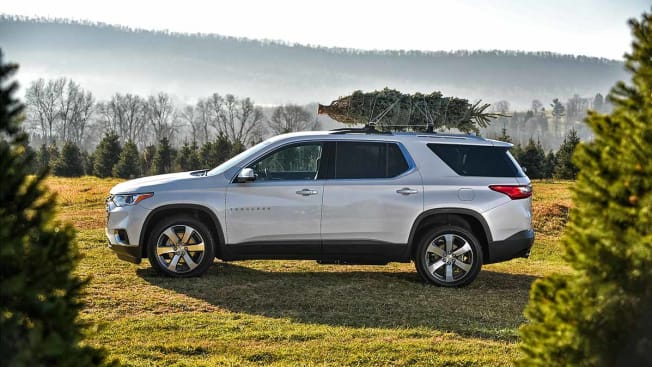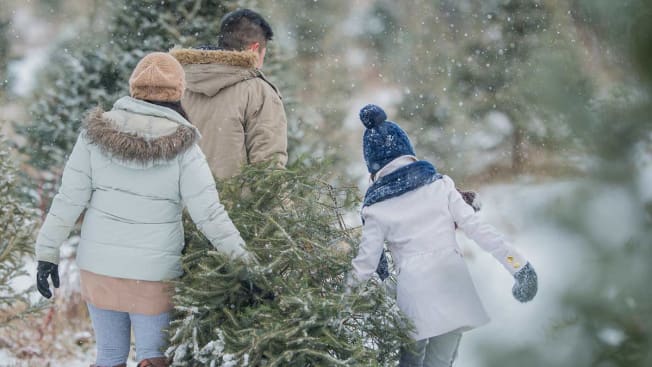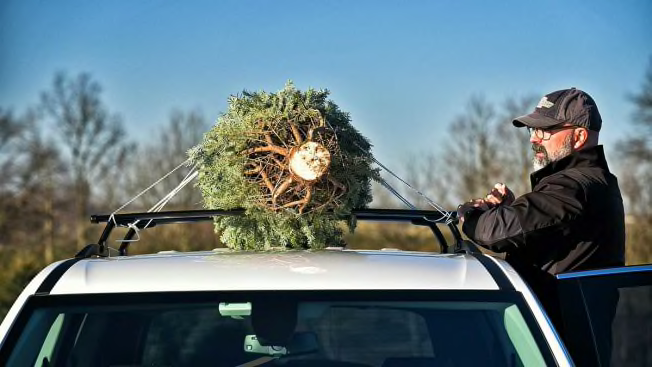Make sure you have the right vehicle and the right tools—or the right delivery plan

By Keith Barry
Last year, 94 million U.S. households put up a Christmas tree, according to the American Christmas Tree Association (ACTA), an industry trade group. But before you decide where to put the tinsel and ornaments, you have to transport your tree home. Get that wrong, and it could pose a hazard to you and your car—not to mention other drivers on the road.
That’s why we talked to a CR auto safety expert, road-safety advocates, automotive engineers, and an industry trade group to find out the tips and tricks for safely transporting trees.
According to a 2019 survey by AAA, 44 percent of Americans who plan to purchase a real Christmas tree will not transport it safely—even though 16 percent of survey respondents say they’ve previously had a Christmas tree fall off or out of their vehicle during transit.
“Everyone’s excited to get a new tree, and probably don’t think much about how to get it home until they get to the lot,” says Greg Brannon, AAA’s director of engineering and industry relations.
Although Brannon told CR he is unaware of any crashes caused by Christmas trees, improperly secured cargo is a serious issue: AAA says that more than 200,000 crashes and 500 fatalities between 2013 and 2017 were caused by road debris. To prevent these dangers, many states fine drivers for carrying cargo in an unsafe manner.
Before you pick out a Christmas tree, here’s what you need to know to bring it home safely.
Bring the Right Vehicle and Equipment
“Make sure you have the right supplies and the right vehicle before you get your tree,” says Jen Stockburger, director of operations at CR’s Auto Test Center.
Unless you can fit your tree inside your vehicle, you’ll need a roof rack and the proper supplies to keep the tree on the roof.
“We recommend dedicated tie-downs, like nylon ratchet straps, particularly if you’re going any distance or traveling at highway speeds,” she says. “The free rope that tree sellers give out just doesn’t cut it.”
You’ll also want to bring along a tarp or a blanket.
“Tree sap is hard to remove from paint, and tree branches can leave scratches, so put something underneath to protect your car,” Stockburger says.
She also recommends buying a tree that has been bagged or netted. This not only keeps branches corralled but also reduces wind resistance during travel, meaning your tree will look much better once it gets home and won’t look like it’s missing branches and needles.
Finally, you should have friends or family at the ready who can help you load and unload the tree.
Don't Have the Right Vehicle?
If you don’t have the right vehicle or don’t feel confident bringing a tree home yourself, you can still get a real tree without making a trek. "Big box" stores like Lowe’s and Costco can ship live trees to customers, and some local tree farms will deliver for an extra fee. There are also dedicated tree delivery services.
There are also artificial trees, which tend to come in boxes smaller than their fully assembled size. "There are many, many, many sites to purchase an artificial tree and have it delivered to your doorstep,” says Jami Warner, ACTA executive director. “That, of course, eliminates the need to transport a tree from a retail center or a farm.”
In some parts of the country, you can even rent a live, potted Christmas tree, which will be delivered to your doorstep and removed—still living—at the end of the season.

Some tree farms offer delivery.
Photo: iStock
Up on the Roof Rack
In AAA’s survey, 20 percent of respondents who plan to purchase a tree said they were going to tie it to the roof without using a roof rack. In addition to creating a safety hazard, transporting a tree that way can damage your car.
If you are bringing a tree home, you need a roof rack, says Art Koby, who worked as an accessories product manager at GM.
“You’re keeping your cargo elevated above the roof,” he says. “Especially if you have a sunroof, you’re going to greatly reduce your chances of damaging the paint or damaging the roof.”
The typical roof rack can carry a load from 110 to 220 pounds, says Joel Batchler, an engineer in charge of roof carriers at General Motors. Typical Christmas trees weigh roughly 50 to 70 pounds, so they should be no problem, he says. Still, “we always recommend owners check with their owner’s manual to check what their roof rack is rated for,” he says.
What about tying a tree to the roof? That’s no good, experts say. Roof racks are designed to have objects fastened to them, but doors and windows are not.
“Too often we see people put a loop of twine through the doors and off you go,” Brannon says. “That’s a great way to create a tear in the seals of the door.” That’s why you should attach your tree to the roof rack, and not to the vehicle.
AAA estimates that tree-related damage could cost anywhere between $100 and $1,500 to repair, depending on how much paint is scratched and whether tying a tree improperly damaged the rubber gaskets that keep water from leaking through a vehicle’s doors.
Sleigh? No. SUV? Yes.
Even if a tree isn’t too heavy, it might be too long for your car. The typical tree is 6 feet tall—fine for most SUVs or station wagons, but twice as long as the roofs of many sedans. That makes vehicles with a long roof ideal for tree transit.
“The general guideline is that you don’t want to obscure your forward upper vision,” Bachler says.
He also warned drivers to be careful about putting a tree in the back of a pickup—state and local laws dictate how far cargo can stick out beyond a truck’s bed, and you may need to attach a red flag to the end of an extra-long load to warn other motorists.
Any tree in the back of a truck should be secured. Still, 24 percent of likely tree buyers who responded to the AAA survey said they planned to place the tree in the bed of a pickup truck without further securing it.
If you have a smaller tree, Koby recommends carrying it inside a vehicle.
“If you’re able to fold your rear seats down flat and carry the tree inside the vehicle vs. outside the vehicle, obviously it’s easier from a loading standpoint,” he says.
Even if the tree is inside of a vehicle, it should be secured so that it doesn’t cause injuries to vehicle occupants in the event of a crash. And put down a large tarp or blanket first so the tree doesn’t leave a mess.

The average Christmas tree is too tall for the roofs of most sedans.
iStock-476618688
Check It Twice
It might seem counterintuitive, but Brannon says a tree’s trunk should be facing forward if it’s tied to the roof. That’s for aerodynamic reasons, because the wind could whip up the smaller end of a tree and ruin it—and might even blow the tree off the car. The heavy trunk will keep the tree settled, and also makes a better anchor point.
“Make sure you anchor it just above the bottom branches,” he says, because the branches above the trunk provide a solid mounting point so the tree won’t come off in the wind or fall if you stop short.

Attach the Christmas tree to a roof rack, and don't run ties through the windows.
Photo: Chevrolet
CR’s Stockburger recommends driving slowly with any cargo on the roof—especially if it’s a tree.
“There’s so much airflow coming up over the top of the car that slowing down will reduce stress on what you’ve used to tie the tree down,” she says. “If you are going any distance, stop to check a few times along the trip to make sure the tree remains securely tied down.”
Even if a falling tree doesn’t cause injury, it could hurt your wallet. In every state, drivers can be fined if an item falls from their vehicle, with penalties as high as $5,000.

Happy memories start with a safely transported tree.
Photo: iStock
Consumer Reports is an independent, nonprofit organization that works side by side with consumers to create a fairer, safer, and healthier world. CR does not endorse products or services, and does not accept advertising. Copyright © 2022, Consumer Reports, Inc.

